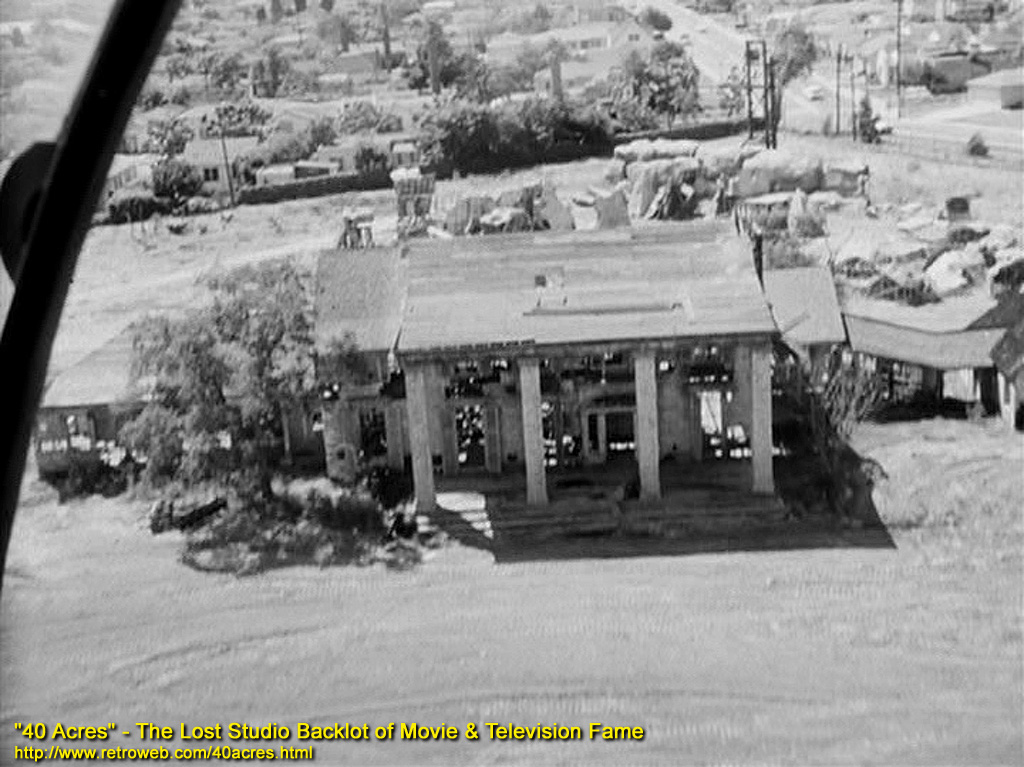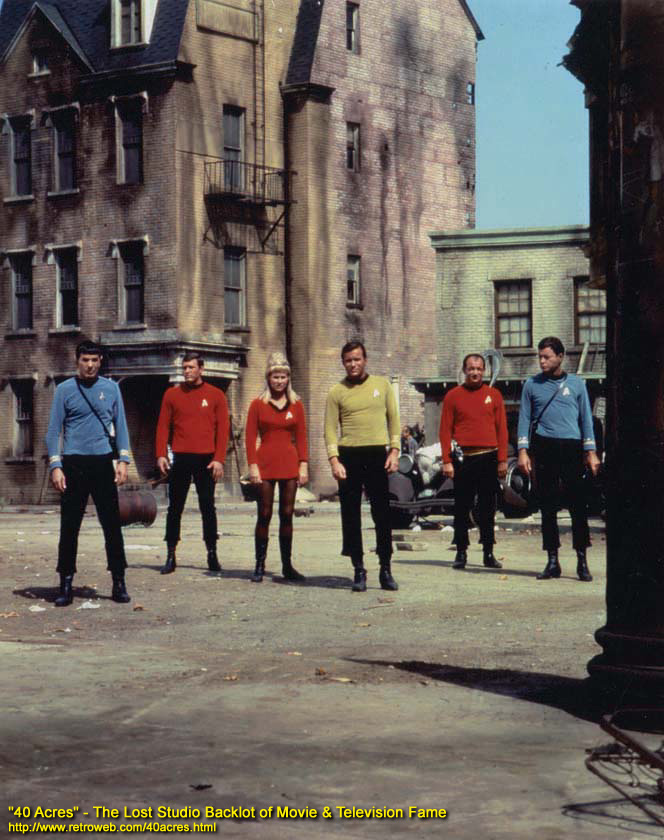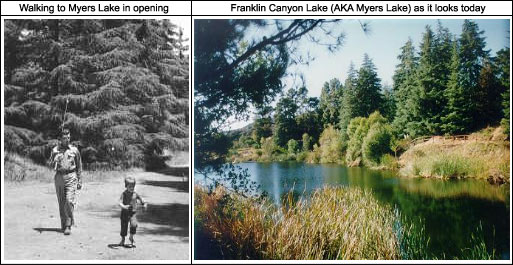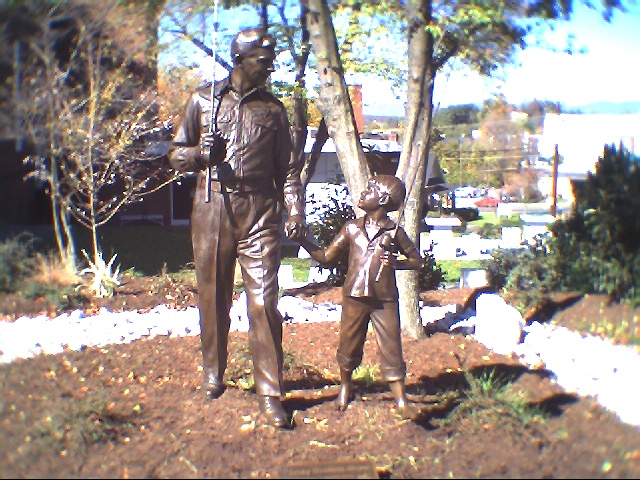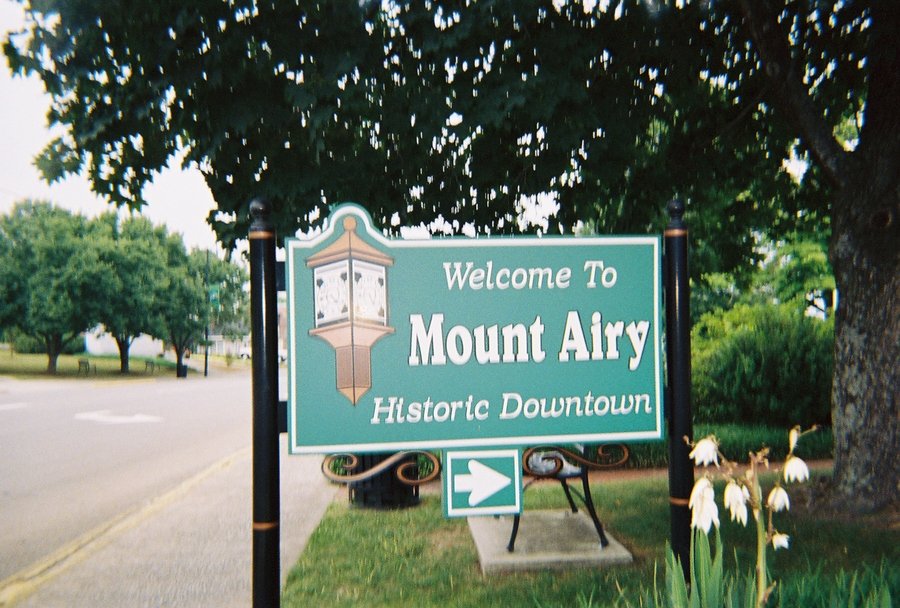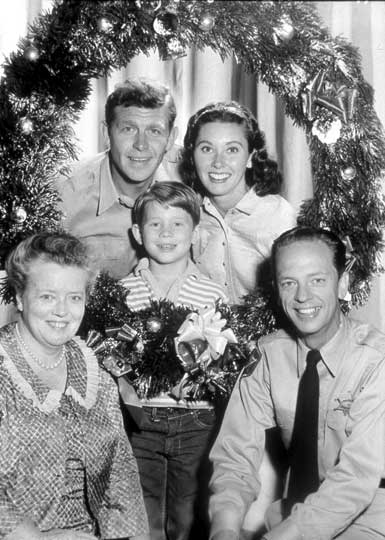Behind The Scenes Of The Real Mayberry
By Jake Easton
http://www.telovation.com/articles/andy-griffith-show.htmlThe Andy Griffith Show is a timeless and heartwarming portrayal of American small-town life during simpler times, where traditional values were cherished, and people respected and cared for one another.
The weekly comedy featured the steady, unflappable Sheriff Andy Taylor (Andy Griffith), the bumbling but hilarious deputy Barney Fife (Don Knotts), Andy's young son Opie (Ron Howard), and theconsummate homemaker Aunt Bee (Frances Bavier).
The backdrop for The Andy Griffith Show (TAGS) was the sleepy little fictional town of Mayberry, North Carolina (population 1800).
While perceived to be hometown, USA, the actual location of Mayberry was not in North Carolina, but in Culver City, California—just down the street from the 1965 Los Angeles race riots. Most of the Mayberry buildings on the 40 Acres set were much taller than they appear on The Andy Griffith Show. Andy and the producers felt that, by keeping the camera angles low, viewers would get more of a small-town feel.
Sheriff Andy’s classic interpretation of ‘Romeo and Juliet’There is significant history to the Mayberry set. The Culver City studio opened in the early 1920s by Thomas H. Ince—his second studio in the city.
In 1928, David Sarnoff, president of Radio Corporation of America (RCA) and Joseph P. Kennedy, merged the largest theater chain at the time, Keith-Albee-Orpheum, with Pathe Studios and the Film Booking Office of America (FBO)—a movie distribution organization acquired by Kennedy two years earlier. The new company was renamed the Radio-Keith-Orpheum Corporation, or RKO Studios.
One of RKO's first movies, The Bird of Paradise, was filmed at this location, then the studio started building up the backlot for jungle and village scenes for what later became the location for the Tarzan and King Kong movies.
Gone With The Wind’s Tara mansion in ruins on the 40 Acres backlot, circa 1959In 1935, David O. Selznick leased the backlot property from RKO to construct the city of Atlanta, a railroad station, and the Tara mansion for the $4 million blockbuster movie, Gone With The Wind.
Several of the “Atlanta” buildings used in the original Gone With The Wind set (that weren't burned down), were later used for the town of Mayberry.
In 1948, multi-millionaire tycoon and movie producer Howard Hughes acquired the studio, made a few forgettable movies, then sold out. It changed hands a few more times until 1956, when Desilu Studios purchased the studio buildings and backlot grounds then affectionately known as 40 Acres.
On this wedge of property adjacent to Ballona Creek (which was actually just under 29 acres), many popular television shows were filmed. (See separate story in this issue for more background on the 40 Acres lot.)
The cast of Star Trek on the 40 Acres lot, mid-‘60s. In the episode ‘City On the Edge of Forever,’ William Shatner and Joan Collins passed in front of Floyd’s Barber ShopOn Star Trek, the most-notable appearances of the 40 Acres lot were in the Miri episode (first airing on October 27, 1966—season 1, episode 8) and “City On the Edge of Forever” (#28 originally airing on April 6, 1967). “City On the Edge” is a classic for The Andy Griffith Show fans where Captain Kirk, Mr. Spock and Dr. McCoy end up in the early 20th century. One of the more interesting shots shows William Shatner and Joan Collins walking down Main Street, passing right in front of Floyd's Barber Shop!
The Darlings visit Sheriff Andy, performing ‘There Is a Time.’ Briscoe Darling, head of the household, was played by Denver Pyle; Charlene Darling was played by Maggie Peterson. The Darling Boys were played by the legendary bluegrass group The Dillards. The Darlings appeared in a total of six episodes during the series’ run.While the outdoor filming was produced at Desilu Studio's '40 Acres' backlot, many of the interior shots were filmed at Desilu's Cahuenga Studios, now Ren-Mar Studios, at 846 N. Cahuenga Blvd. in Hollywood. Old Desilu production schedule reports reveal that The Andy Griffith Show reserved Desilu-Cahuenga's Stage 1 and 2 for Thursday through Wednesday shoots (with weekends off) for each of the 249 episodes they produced.
In 1967, Desilu sold the studio buildings and backlot to Gulf & Western Industries, and later to Paramount Studios—a G&W subsidiary. All good things must eventually come to an end, however, and in 1976 the 40 Acres backlot was bulldozed to make room for an industrial park.
Mayberry's Fishing Hole
At left, Andy and Opie walking to the fictional Myers Lake in the opening credits of The Andy Griffith Show; at right, Franklin Canyon Lake as it looks today.Myers Lake, as it was affectionately called, is shown during the opening “fishing hole” credits and used in several episodes of The Andy Griffith Show. The lake used on the show is actually Franklin Canyon Lake (originally Upper Franklin Canyon Reservoir), located at 2600 Franklin Canyon Drive in Beverly Hills, California.
William Mulholland began construction of the reservoirs of Franklin Canyon in 1916, where there is currently 605 acres of parkland, the three-acre lake, a small duck pond, and an oak woodlands forest that remains one of the last available wilderness areas in Los Angeles.
Andy performs ‘Whoa Mule’ with The Country Boys, whose members include Roland and Clarence White.This location has been heavily used by the television and movie industry over the past fifty years. In addition to The Andy Griffith Show, Combat, Bonanza, Star Trek, How the West Was Won and the movie On Golden Pond, with Katharine Hepburn and Henry Fonda, were filmed here. The lake and park area, now managed by the National Park Service, is open to the public.
Myers Lake was named after Frank E. Myers, the production manager for The Andy Griffith Show. His name was also used in episode 39, in which Andy is forced to evict Frank Myers from his home only to find that Myers had kept an old Mayberry bond that is first believed to be worth over $300,000.
Colin Male was the uncredited, yet distinctive announcer for the show's opening when Andy and Opie walk to Myers Lake. Male also acted in one episode, playing the game warden that caught Andy and Helen without a fishing license (episode 140, “Andy and Helen Have Their Day”).
Stars Made in Mayberry
Waiting on Sheriff Andy, The Dillards cut out on ‘Shady Grove,’ Maggie Peterson, lead vocal.Other than The Andy Griffith Show's (TAGS) starring roles, few television viewers were familiar with the show's supporting cast. That, however, soon changed. In addition to Jim Nabors's phenomenal success with Gomer Pyle, U.S.M.C., the small town of "Mayberry, North Carolina" was visited by a number of actors who became prominent on TV and/or in the movies.
Among the actors making guest appearances on The Andy Griffith Show in the 1960s were: Buddy Ebsen (The Beverly Hillbillies, Barnaby Jones), Barbara Eden (I Dream of Jeannie), Jack Nicholson (two TAGS episodes), Bill Bixby (My Favorite Martian), Denver Pyle (Dukes of Hazzard), Edgar Buchanan (Petticoat Junction), Frank Sutton (Gomer Pyle, USMC), Jamie Farr (MASH), Larry Hovis (Hogan's Heroes), Ronnie Schell (Gomer Pyle, USMC—two TAGS episodes), Teri Garr, George Kennedy, Gavin MacLeod (The Mary Tyler Moore Show, Love Boat), Bob Denver (The Many Loves of Dobie Gillis, Gilligan's Island), Rob Reiner (All in The Family), Arte Johnson (Laugh-In), Don Rickles, Jerry Van Dyke (Coach), Morgan Brittany (Dallas), Joyce Van Patten, Sue Ane Langdon, Jesse White (The Maytag Repairman), Ruta Lee, John Dehner, Bernard Fox (Bewitched), Alan Hale (Gilligan's Island), Jack Albertson (Chico and the Man), and WKRP's Howard Hesseman (two TAGS episodes).
A total of eight TV Guide covers for The Andy Griffith Show were published between January 28, 1961 and July 13, 1968. Between 1965 and 1969 Andy had two additional covers for Matlock, Don Knotts had one more in 1970, and Jim Nabors had four covers for Gomer Pyle, U.S.M.C.As shown above, the TV Guide issues for The Andy Griffith Show included: January 28, 1961 (Andy and Ron Howard), May 12, 1962 (Don Knotts), May 11, 1963 (Andy, Don Knotts, and Ron Howard), March 21, 1964 (Andy, Don Knotts, and Jim Nabors), April 24, 1965 (Andy Griffith), June 4, 1966 (Andy Griffith with guitar), May 20, 1967 (Andy with Anita "Helen" Corsaut), and the last TV Guide was an illustration depicting Andy on the shoulders of Don Knotts and Jim Nabors for the July 13, 1968 issue.
Like most TAGS episodes, there was considerable delay between filming and actual airing. While shooting wrapped on the set of "The New Doctor" episode on January 25th, it didn't air until March 27, 1961, more than eight weeks after filming was completed.
Shazaaaam! Gomer Becomes a Marine!
America's favorite gas station attendant, Gomer Pyple, quickly became America's favorite befuddled Marine, as Jim Nabors' career change moved him less than 10 yards from the set of Wally's Service Station, to the set of the Camp Pendleton Marine Base—all on the 40 Acres backlot.
Jim Nabors' character, Gomer Pyle, first appeared in Mayberry during the show's third season on January 14, 1963 (#79 “Man in a Hurry”), then continued for one and a half seasons when Andy helped him move on to his own hit CBS series on May 18, 1964 (#127 Gomer Pyle U.S.M.C.). Gomer Pyle, U.S.M.C., which ran through 1969, was also a ratings hit during its six-year run.
The Mount Airy Connection
A statue of Sheriff Andy Taylor and his son Opie, in Mt. Airy, NCWhile Griffith often dismissed any ties between his show and the sleepy little town of Mount Airy, North Carolina, even Andy can't deny the many similarities.
For example, if you've wondered where the talented TAGS writers came up with the various names, it's apparent they didn't have to look far from Andy's hometown. The small towns surrounding Mount Airy—where Andy Griffith was born in 1926—were a treasure trove for many of the now-familiar characters and locations seen on the show.
Among the names too obvious to ignore are: Mulberry, NC (Mayberry), Pilot Mountain, NC (Mount Pilot), Taylorsville, NC (Andy Taylor), Lawsonville, NC (Floyd Lawson), Crumpler, NC (Helen Crump), Walkertown, NC (Ellie Walker), Jonesville, NC (Sam Jones), Warrensville, NC (Warren Ferguson), and Stoneville, NC—Mayor Stoner (That's “Stoner,” for those who recall the "Barney and the Governor" episode). All of these little municipalities are less than 25 miles from where Andy grew up.
Other TAGS characters were named after real people, including childhood friends, family and acquaintances such as Andy's best buddy since grammar school—Emmitt Forrest, and former Mount Airy mayor E.T. Clark (collectively "Emmett Clark"), Jim Slate (Jim Slater), the Beasleys (Juanita, and Goober in one episode), the Roundtrees (Miss Roundtree), Earl Gilley—and to keep his in-laws happy—Andy's then-wife Barbara Edwards Griffith (Clara Edwards, who was in 21 episodes).
‘Just jump in where you can and hang on!’ Andy joins the Darlings in jail for some fine picking after supper.In addition to the real North Carolina cities of Charlotte, Raleigh, Bannertown, and Siler City, many streets provided a bridge between fact and TV fantasy. There's Haymore Street (Andy and his parents, Carl and Geneva, lived at 711 Haymore), Rockford Street (where Andy's grammar school was located), Main Street, Turner Mountain (Turner's Grade—speed limit 35mph), Oak, Elm, Maple, Willow, Orchard, and River Road—all the rural byways of Mount Airy.
Town With An Identity Crisis
Mount Airy, North Carolina, comes from established roots in the heart of the Blue Ridge foothills. The town was incorporated in 1885, and over the next fifty years, the Surry County area was among the state's largest producers of tobacco, furniture manufacturing, textiles, and granite.
With more than a century having passed, and all the big industries long gone, Mount Airy—population 8,484—is now home to a few hosiery manufacturers, some scattered wineries, and a dozen small manufacturing companies. One of the town's largest employers, NCFI, manufactures polyurethane foam insulation products—and yes—they were the foam supplier to NASA for the space shuttle fuel tanks.
Crime has also become an issue recently, when Betty Lou Lynn (Barney's girlfriend Thelma Lou) was robbed of her wallet and $130 on the streets of Mount Airy after moving from Los Angeles. Lynn said she had moved to “Mayberry” after becoming fed up with crime in Los Angeles. She reported being victimized by a series of incidents. “I’d been robbed on the street twice, and once in a department store,” Lynn said during the interview, and had her home broken in to twice.
To offset its weakened economy, it seems like the whole town of Mount Airy has turned to tourism as a way to fan the demand flame for 'everything Andy.'
Starting in the early 1980s—twenty years after The Andy Griffith Show was produced—Mount Airy's City Barber Shop became Floyd's City Barber Shop, the Mount Airy Inn became The Mayberry Inn, then came the Mayberry Mall, Mayberry Cinema, Mayberry Antiques, Mayberry Alarm & Lock Co., Mayberry Waterworks (Car Wash), Mayberry Country Hair World, Mayberry Candle Shop, Mayberry Coffee Company, Mayberry Embroidery, Mayberry Learning Center, Mayberry Square, Mayberry R.F.D. Developers, Mayberry Collectors Center, Mayberry Bed & Breakfast, Simply Mayberry Gifts, Andy's Homeplace Bed & Breakfast, The Andy Griffith Museum, The Andy Griffith Theater, Aunt Bea's Barbeque (albeit misspelled), Aunt Bee's Room, Wally's Service Station, Bluebird Diner, the Old Mayberry Jail, and Knight's Inn Mayberry.
Andy and the Dillards get it going on ‘Boil Them Cabbage Down’ with guest vocal by Bob DenverOne notable exception to the madness, is the Snappy Lunch diner. On November 14, 1960, in the seventh show to air (Episode 9—"Andy the Matchmaker"), Barney had been walking shy seamstress, Miss Rosemary to church every Sunday. Andy decided it was time to get them together and suggested they "take in a movie, then go down to the Snappy Lunch to eat, have some coffee, and talk."
The real life Snappy Lunch diner is Mount Airy's oldest business whose southern heritage goes back to 1923, and a spot where Andy himself ate as a young boy. The diner's owner, Charles Dowell, nearly fell off his couch when he saw that episode in 1960—and business at the Snappy Lunch diner has prospered ever since.
While subsequent episodes often have Andy and Barn going to “the diner,” it's clear to Mount Airy residents that they were referring to their very own little Snappy Lunch eatery.
Epicurean note: If you're in the neighborhood, be sure to try Snappy Lunch's tasty cheeseburger for $1.55, or if you're feeling particularly decadent, go all out for the mouth-watering World Famous Pork Chop sandwich for $3.50. They're open Monday through Saturday for breakfast and lunch—and just like Wally, they don't work on Sundays.
While continuously dismissing any ties between The Andy Griffith Show and Mount Airy for decades, on October 16, 2002, Andy Griffith publicly returned to Mount Airy for the first time in 45 years to be honored by North Carolina Gov. Mike Easley in renaming a ten mile stretch of Highway 52 to Andy Griffith Parkway.
Andy and the Dillards pick up a storm on ‘Doug’s Tune’ as Briscoe Darling busts a move on Aunt Bea.During the dedication ceremony, Andy, then 76, said, "I'm proud to be from the great state of North Carolina. I'm proud to be from Mount Airy. I think of you often, and I won't be such a stranger from here on out."
Then he gave the local residents what they had been hoping for, for years: Validation. "People started saying that Mayberry was based on Mount Airy," Griffith said. Then pausing with a sly grin, he added: "It sure sounds like it, doesn't it?"
Originally published at Telovation.com, http://www.telovation.com/), September 03, 2009.
Telovation: Inspiration for Curious Minds—Telovation provides no-nonsense reporting on everything new, cool, and interesting in the world of technology, gadgets, and innovation. Telovation.com is a web news magazine that provides daily reports on the latest achievements in the world of technology, art, design, innovation, and interesting people and things from around the world.
Founder/Publisher/Editor: David McGee
Contributing Editors: Billy Altman, Laura Fissinger, Christopher Hill, Derk Richardson
Logo Design: John Mendelsohn (www.johnmendelsohn.com)
Website Design: Kieran McGee (www.kieranmcgee.com)
Staff Photographers: Audrey Harrod (Louisville, KY; www.flickr.com/audreyharrod), Alicia Zappier (New York)
E-mail: thebluegrassspecial@gmail.com
Mailing Address: David McGee, 201 W. 85 St.—5B, New York, NY 10024


